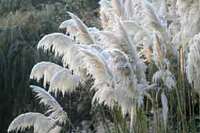June brings the later Peonies, the many beautiful varieties of P. albiflora. The great number now in commerce present a difficulty in making a choice without some guidance. This is the more to be desired because numbers of the rose-coloured kinds have a taint of rank colouring that is best avoided. The following varieties may be advised :�Whites: Virgo Maria, Duchesse de Nemours, Festiva maxima, Marie Lemoine, grandiflora nivea plena.
Yellowish:Solfatarre, alba sulfurea. Flesh colour: Virginie, EugTnie Verdier, carnea alba, La Tulipe. Fuller pink and rosy: Dr. Bretonneau, Mme Calot, Mme de Vatry, Belle Douaisienne, Mme Dhour. Dark red: Edonard AndrT. These grand Peonies are worthy of an entire garden space to themselves, though they are also in place as either simple plants or as groups of two or three in flower borders. One good way of having them is intergrouped with the Roses in a Rose garden, where the beds are apt to look thin and unfurnished; a weakness that the large foliage of the Peonies tends to correct.
Another great family of June-flowering plants contains the most useful of the Irises, namely, the flag-leaved kinds. A large number of fine new varieties have been produced of late years, but some of the old-established kinds are still among the best; and as the prices of these are moderate it may be useful to name them in preference to those of the latest development, whose colours and qualities can be learnt from any good Iris catalogue. These can confidently be recommended. For whites, albicans Princess of Wales, and Mrs. H. Darwin; white, bordered with purple lines, Mme Cherean; purple, the nearest to blue, Chameleon; all purple, tall and vigorous, Kharput; dwarf, deep purple, early, Purple King; purple and white, low growing, Comte de St. Clair, and Sultana taller; pale yellow, flavescens; deep yellow, variegata aurea; yellow and bronze, Bronze Beauty, Gracchus, Darius; lavender, the grand Pallida datmatica and its near variety P. d. Celeste, also the nearly related pinkish Queen of the May. A whole Iris garden is no doubt desirable, but it would have to be carefully interplanted with something of which the foliage would overspread the Irises, because, except in the case of the pallidas or varieties with near pallida parentage, the leaves wither up and become unsightly. But this does not matter if a special bit of garden can be given to the Irises and a few other flowers of June, and treated carefully for colour effect. Such a place should be rather separate from other garden ground, as it would not be of interest either earlier or later in the year. It would begin at one end with Irises purple and white, purple perennial Lupins, pink China Rose, and the beautiful little shrub, Olearia stellulata, which is covered in June with its myriad of little starry white flowers. Then Irises of a lighter purple, the kinds that are nearest to blue, and the fine white Oriental Poppy, Perry�s White, and white Lupins. All this region has a plentiful planting of white Foxglove at the back. Then comes the pale yellow Iris flavescens with one of the shorter yellow Irises in front, and a goodly planting of yellow Tree Lupin, followed by the deeper yellow Iris variegata aurea; all this with a front and middle underplanting of the reddish satin-leaf Heuchera Richardsonii. This underplanting is continued as the Irises darken in colour to those that have claret falls and smoky yellow standards. After this the colour again passes to yellow, with a good deal of interplanting of a most useful plant, Peltaria alliacea, about a foot high, with a cloud of tiny cruciferous bloom of a warm white colour. Then there are again white Irises and China Roses and the pretty rosy tall Iris, Queen of the May, one of the latest of the pallidas; for the fine Iris pallida dalmatica is a little too early for the Iris border, its bloom being over before the greater number of the more numerous kinds are in flower. The end of the border has some white Tree Lupins, the tall warm white spires of Asphodel and the creamy plumes of Spirea Aruncus.
The colouring of Roses has been so much altered and extended of late that in planning a Rose garden the separate needs of the newer shades should be� kept in mind. For though Roses pink and white, and red and white, and pink and red are fine in company, the whites and some of the cooler pinks do not agree with the salmon and orange shades, although the whites and pure pale� yellows inclining to a canary tint go charmingly together. The following combinations may be advised :�White and yellow: British Queen, Ethel Malcolm, Kaiserin Augusta Victoria, whites; Souvenir de Gustave Pratt, Miss Alice� de Rothschild, yellows. For deeper yellows: Lady Hillingdon, Mme Ravary, ]JlTlanie Soupert, Mrs. Wemyss Quin, Margaret Dickson Hamill, and Golden Emblem. For pink: Dean hole, Mme Jules Grolez, Prince de Bulgarie, La� Tosca, Antoine Rivoire, Lady Ashtown. For copper orange: Joseph Hill,. A.R. Goodwin, Duchess of Wellington, Lady Pirrie, Mme Edward Herriot, and Sunburst. For bright reds: Richmond, George C. Waud, General McArthur,. Mrs. Edward Powell, Commander Jules Gravereau, Hugh Dickson, K. of K.,. Augustus Hartmann, and Red Letter Day. For darkest reds: Eugene Beauharnais, Chateau de Cbs Vougeot, Laurent Carte, Lieutenant Chaure, and George Dickson.

